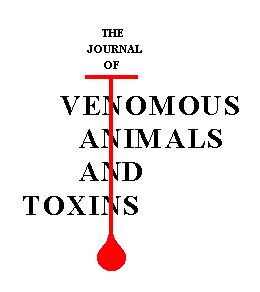THESIS: E.L.A. Malpezzi submitted this dissertation for the degree of Master of Science, publicly examined at the Department of Physiology of the Institute of Biosciences, University of São Paulo, São Paulo, Brazil, in June 1992.
Advisor: Professor José Carlos de Freitas
ABSTRACT. The Brazilian sea anemone Bunodosoma caissarum possesses biologically active compounds. The purpose of this work was to study some substances present in the tissues and the toxins contained in the nematocysts. The hydroalcoholic extract of the whole sea anemone showed both cytotoxic and antimitotic activities on sea urchin egg development, and this effect was increased after its fractionation and purification. Taurine, an aminoacid found in large amounts in cnidarian tissues, and N-methyltaurine isolated from B. caissarum by other authors, were inactive in terms of cytotoxic and antimitotic activities. The study with the nematocysts of B. caissarum started with tests to obtain cnidocyte capsules in vitro as well as their venom. However, as previous techniques used with this species were not successful, we used an in vivo method. The venom was obtained by electrical stimulation of the animals temporarity maintained in artificial sea water, using a stimulator and two carbon electrodes, followed by filtration and storage at -20 C. The nematocyst venom was lethal to mice both via i.p. and oral administrations. The cytotoxic action was well marked and dose dependent on isolated sea urchin, but the venom did not cause any alteration in their further stages of development. Another effect was the dose dependent hemolysis on washed erythrocytes from different vertebrates. This effect was inhibited by increasing concentrations of sphingomyelin, indicating that the phospholipid may act as an acceptor for the hemolysin. Isolated sensory nerves of crustacean leg were used in the neurotoxicity studies. The venom initially induced a sudden increase of action potential discharges, but with further increase in concentrations, a decrease of discharges occurred up to the blockade of nerve conduction. The effect was avoided by tetrodotoxin. Using the same nerve in the sucrose-gap assays, an increase of the action potential duration was observed, apparently without effects on the K+ outward current. Preliminary experiments with isolated guinea-pig auricles showed light positive chronotropic and strong inotropic effects induced by the venom. Biochemical analysis of the venom, revealed that the active substances are low molecular weight peptides. The neurotoxic components are thermostable, while the hemolytic was inactivated when heated. The neurotoxic fraction was composed of 3 peptides, BcIII being the predominant one, with 48 aminoacid residues and a calculated mol. wt of 4.973 Da with 3 disulfide bonds. The primary structure is homologous with the other type 1 long neurotoxins isolated from other sea anemones. The hemolytic fraction is composed of one peptide with a 14 KDa mol. wt. The present work adds to the previously reported substances isolated from this species (caissarone and N-methyltaurine) a cytotoxic substance which inhibits cell division, 3 neurotoxic and 1 hemolytic peptide.
REFERENCES
01 MALPEZZI ELA., FREITAS JC. Antimitotic effect of an extract of the sea anemone Bunodosoma caissarum on sea urchin egg development. Braz. J. Med. Biol. Res., 1990, 23, 811-4.
02 MALPEZZI ELA., FREITAS JC. Hemolytic activity of the nematocyst venom from the sea anemone Bunodosoma caissarum.Braz. J. Med. Biol. Res., 1991, 24, 1245-9.
03 MALPEZZI, ELA., FREITAS, JC. Action of nematocyst venom from the sea anemone Bunodosoma caissarum (Cnidaria, Anthozoa) on the crustacean nerve. Recent Adv. Toxinol. Res., 1992, 2, 408-17.
04 MALPEZZI ELA., FREITAS JC., MURAMOTO K., KAMIYA H. Characterization of peptides in sea anemone venom isolated by a novel procedure. Toxicon, 1993, 31, 853-64.
CORRESPONDENCE TO:
E. L. A. MALPEZZI - Departamento de Fisiologia - Instituto de Biociências - Universidade de São Paulo - Rua do Matão, Travessa 14, No. 101 - CEP 05508-900 - São Paulo - SP - Brasil.
Publication Dates
-
Publication in this collection
11 Oct 2001 -
Date of issue
1996


